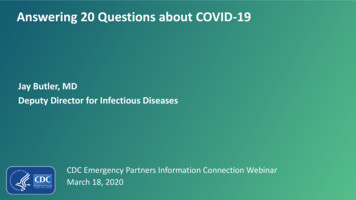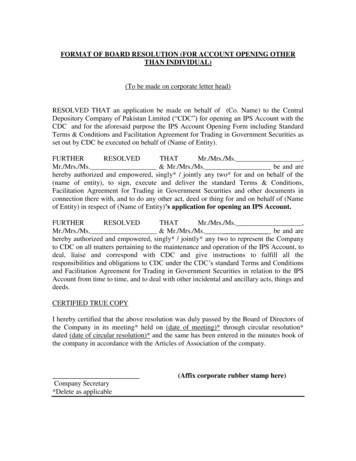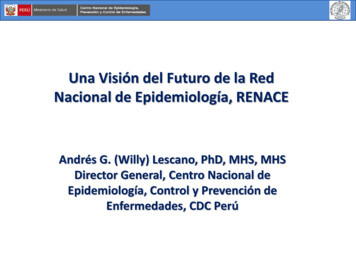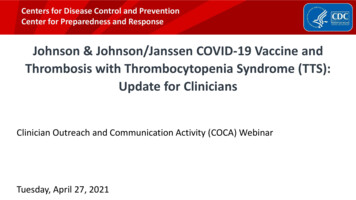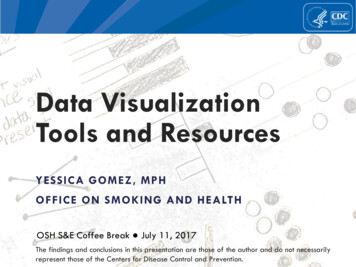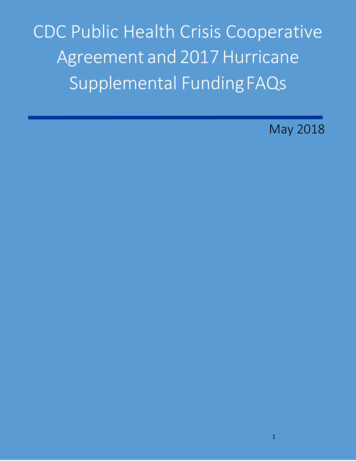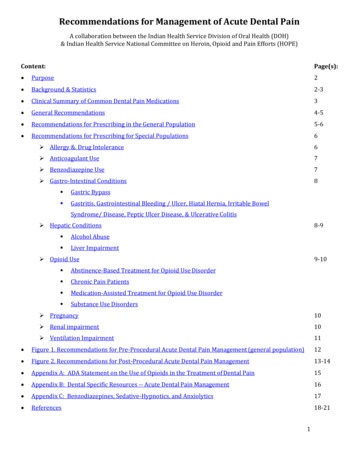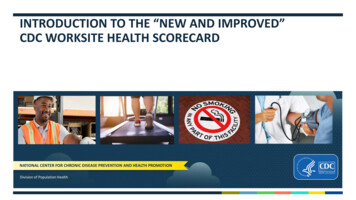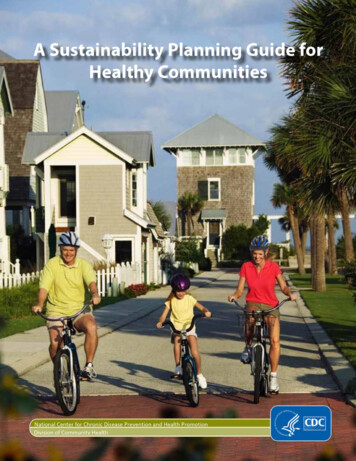
Transcription
CDC’s Healthy Communities ProgramSustainability Planning GuideAcknowledgementsSUSTAINABILITY PLANNING GUIDE TEAMThe Centers for Disease Control and Prevention’s (CDC) Healthy Communities Program recognizesthe following individuals for their dedication and commitment to developing the SustainabilityPlanning Guide and related materials.Marilyn Batan, MPHNorthrop GrummanHealthy Communities ProgramDivision of Adult and Community HealthNational Center for Chronic Disease Prevention and Health PromotionCenters for Disease Control and PreventionFrances D. Butterfoss, PhD, MEdPresident, Coalitions WorkSenior Project ConsultantSociety for Public Health Education (SOPHE)Anthony Jaffe, MSColumbus Technologies and ServicesHealthy Communities ProgramDivision of Adult and Community HealthNational Center for Chronic Disease Prevention and Health PromotionCenters for Disease Control and PreventionTim LaPier, MAPublic Health EducatorHealthy Communities ProgramDivision of Adult and Community HealthNational Center for Chronic Disease Prevention and Health PromotionCenters for Disease Control and Prevention2
CDC’s Healthy Communities ProgramSustainability Planning GuideCONTRIBUTORSThe Sustainability Planning Guide was developed in collaboration with the Centers for Disease Control andPrevention (CDC), Coalitions Work; Center for Civic Partnerships, Prevention Institute, YMCA of the USA (YUSA), Society for Public Health Education (SOPHE), DeKalb County Board of Health, Health Assessment andPromotion, Office of Chronic Disease Prevention, Live Healthy DeKalb (Ga.) Coalition. In addition, CDC’sHealthy Communities Program recognizes the following individuals who contributed subject-matter expertiseand editorial guidance.Manal AboelataProgram DirectorPrevention InstituteKirsten Frandsen, BSPhysical Activity, Nutrition, and Tobacco PreventionCoordinatorTacoma-Pierce County Health DepartmentZarnaaz Bashir, MPHDirectorStrategic Health InitiativesNational Recreation and Park AssociationJyotsna M. Blackwell, MPHCoordinatorOffice of Chronic Disease PreventionDeKalb County Board of HealthShannon Griffin-Blake, PhDTeam LeadProgram Services and EvaluationHealthy Communities ProgramDivision of Adult and Community HealthNational Center for Chronic Disease Prevention andHealth PromotionCenters for Disease Control and PreventionLarry CohenExecutive DirectorPrevention InstituteBruce Hathaway, BAHealthy Communities Technical AdvisorNew York State Department of HealthAlyssa Easton, PhD, MPHDirectorHealthy Communities ProgramDivision of Adult and Community HealthNational Center for Chronic Disease Prevention andHealth PromotionCenters for Disease Control and PreventionCynthia A. Jaconski, MPH, CPH, MCHESDirector of Healthier Communities ProgramsBureau of Community Chronic Disease PreventionNew York State Department of HealthPhyllis J. Nichols, MPHPublic Health AdvisorProgram Services and EvaluationHealthy Communities ProgramDivision of Adult and Community HealthNational Center for Chronic Disease Prevention andHealth PromotionCenters for Disease Control and PreventionChristy Filby, BSCommunity Wellness ExecutiveTwo Rivers YMCAScott County Family Y3
CDC’s Healthy Communities ProgramSustainability Planning GuideTyler NorrisSenior Advisor, Kaiser PermanenteHead Coach, YMCA of the USAPioneering Healthier CommunitiesCo-Founder, Community InitiativesAlexandria Stewart, BSWorkforce and Partnership Development LeadCommunity Health and Equity Branch (CHEB) (formerly CHAPS)Division of Adult and Community HealthNational Center for Chronic Disease Prevention andHealth PromotionCenters for Disease Control and PreventionAlice Patty, MSHACHIEVE Project ConsultantNational Association of Chronic Disease DirectorsLily SwartzProgram AssistantPrevention InstituteTiffany Pertillar, MSW, MPH, CHESProject DirectorHealthy Communities InitiativeSociety for Public Health EducationBrian Talcott, MSWOrganizational Development SpecialistCenter for Civic Partnerships, Public Health InstituteJoseph Ralph, MPH, CHESLT, United States Public Health ServiceSenior Assistant Health Services OfficerHealthy Homes and Lead Poisoning PreventionBranchDivision of Emergency and Environmental HealthServicesNational Center for Environmental HealthCenters for Disease Control and PreventionJacqueline H. Tran, MPHDirectorCenter of Excellence to Eliminate Disparities in Breastand Cervical Cancer among Asian and Pacific Islander Women (REACH US)Orange County Asian and Pacific Islander Community Alliance, Inc. (OCAPICA)Monte RoulierPresidentCommunity Initiatives (CI)Stephanie Sargent Weaver, PhD, MPH, CHESSenior Evaluation SpecialistNorthrop GrummanProgram Services and Evaluation TeamHealthy Communities ProgramDivision of Adult and Community HealthNational Center for Chronic Disease Prevention andHealth PromotionCenters for Disease Control and PreventionDennis Shepard, MATSenior Program ManagerHealthier Communities InitiativesYMCA of the USATracy L. Wiedt, MPHProject DirectorHealthier Communities InitiativesYMCA of the USA4
CDC’s Healthy Communities ProgramSustainability Planning GuideAbout CDC’s Healthy Communities ProgramIn October 2003, as part of the U.S. Department of Health and Human Services’ Steps to a HealthierUS initiative (Steps), the CDC began funding communities nationwide through 5-year cooperative agreements, withYMCA of the USA (Y-USA) as a national partner. Building on successes and lessons learned from Steps, CDCbroadened its investment in communities through the creation of CDC’s Healthy Communities Program inJanuary 2009.To date, more than 300 communities nationwide have been selected by CDC to implement policy, systems,and environmental change (PSE) strategies. CDC’s Healthy Communities Program works with these communities, as well as with state and local health departments and national partners, to help create a culture ofhealthy living while building national networks for sustainable change. Through the Strategic Alliance for Health (SAH), CDC’s Healthy Communities Program is able to partnerdirectly with states and communities. Through Action Communities for Health, Innovation, and Environmental Change (ACHIEVE) andPioneering Healthy Communities (PHC), CDC’s Healthy Communities Program works with a host ofnational organizational partners, including the National Association of Chronic Disease Directors(NACDD), National Association of County and City Health Officials (NACCHO), National Recreation andPark Association (NRPA), Society for Public Health Education (SOPHE), and Y-USA.Key program elements include: Mobilizing national networks to provide technical support and training to communities. Providing funding to develop policy strategies. Connecting leaders and providing training on how to undertake effective policy strategies. Disseminating effective strategies and tools to build the capacity of partners and communities. Monitoring and evaluating strategies and integrating new practical approaches into the Healthy Communities scope of work.Through these efforts, CDC’s Healthy Communities Program and its partners aim to take the following community-level actions: Engage community members in healthful activities where they live, work, worship, play, and learn. Analyze local health issues to take effective action. Shape policies and sustainable environments that promote and sustain health and quality of life. Create sustainable, community-based improvements that address the root causes of chronic diseasesand related risk factors. Learn from past efforts and look ahead to meet future health challenges.5
CDC’s Healthy Communities ProgramSustainability Planning GuideAbout the Sustainability Planning GuideImproving the health and well-being of a community is no simple task for a coalition. It takes long-term policystrategies for sustaining change in systems and environments. And it takes the necessary community and organizational infrastructure for carrying out those strategies. In short, a coalition needs a comprehensive planfor sustaining its public health efforts, one that can help it manage internal and external challenges.The Sustainability Planning Guide is a synthesis of science- and practice-based evidence designed to helpcoalitions, public health professionals, and other community stakeholders develop, implement, and evaluate asuccessful sustainability plan. The Guide provides a process for sustaining policy strategies and related activities, introduces various approaches to sustainability, and demonstrates sustainability planning in action withreal-life examples.The sustainability approaches described in this guide were developed with the help of an advisory panelthat included experts on sustainability planning and approaches (listed on pages 2-4). Specific contributionsinclude the following: Y-USA drew on multiple research streams and community surveys to determine sustainability needs aswell as gather sustainability stories from the field. The Center for Civic Partnerships (CCP) contributed a version of its 10-step process for guiding communities through sustainability planning. These steps, including tools and resources, are based on CCP’snearly 10 years of sustainability training throughout the country. The Prevention Institute synthesized research and practice into a process for developing local policy,which can help practitioners and decision makers achieve long-term improvements and comprehensive, sustainable change.6
CDC’s Healthy Communities ProgramSustainability Planning GuideIntroductionToday, more than ever, community leaders understand that improving the health and well-being of individualsand families means changing health-related behaviors—and that means addressing factors that influencethose behaviors. In light of changing funding opportunities and increased competition for resources, communities need to ensure that they maintain the capacity to work in partnership to identify and address publichealth challenges, and that their resulting health initiatives can have lasting—that is, sustainable—impact.Sustainability is not just about funding. It’s about creating and building momentum to maintain communitywide change by organizing and maximizing community assets and resources. It means institutionalizing policies and practices within communities and organizations. From the outset, sustainability requires an approachthat emphasizes the development of a network of community practitioners who understand and can lead aHealthy Communities Movement. It also means involving a multiplicity of stakeholders who can develop longterm buy-in and support throughout the community for your coalition’s efforts. These elements are crucial toensuring lasting change and making a difference in people’s lives.What is the Healthy Communities Movement?The Healthy Communities Movement is a growing global effort to improve the health and well-being ofindividuals and families, primarily through policies that sustain positive, lasting changes to local, state, and national systems and environments. In the United States, this movement is made up of thousands of multi-sectorcommunity collaborations working to develop policies where people live, work, learn, play, and worship. Inaddition to the CDC, the movement includes hospitals and health systems; state and local health departments; community-based, faith-based, and philanthropic organizations; schools and universities; businesses;media organizations; national policy-focused organizations; and civic and social networks.7
CDC’s Healthy Communities ProgramSustainability Planning GuideWhat is Sustainability?The Guide’s working definition of sustainability is: A community’s ongoing capacity and resolve to work togetherto establish, advance, and maintain effective strategies that continuously improve health and quality of life for all.Sustainability is not just about achieving public health goals; it also relates to concepts such as social justiceand socioeconomics. But to keep public health sustainability tasks clear, doable, and supported by committed partners, we encourage coalitions, organizations, and communities to focus their issues, strategies, goals,and resources on policies that aim to improve health and well-being. They should consider linking with localgroups working outside public health (e.g., transportation departments, parks and recreation departments)whose efforts complement their own.8
CDC’s Healthy Communities ProgramSustainability Planning GuideWho Should Use This Guide, and Why?For simplicity’s sake, we will be referring primarily to your coalition—a collection of individuals and organizations working together to achieve specifics goals. But the Guide is for everyone working to create sustainable,healthy communities. This audience includes, but is not limited to: community leaders; coalition members;national, regional, and local health organizations; state and local health departments; businesses; and nonprofits.The Guide can help your coalition: Develop a hopeful, yet realistic, vision of a healthier community. Identify common issues, and organize local resources accordingly. Connect people and organizations with one another. Anticipate and better prepare for changes in your coalition, organization, or community. Define what sustainability means to your effort, and what parts of it should be sustained. Proactively develop milestones to gauge the effectiveness of your coalition, organization, or community effort. Clarify policy strategies and activities in a formal action plan. Develop a sustainability plan to explain how these efforts will be maintained in the long run. Establish evaluation practices for determining the effectiveness of your coalition’s organizational andpolicy strategies.Why is it important for coalitions to develop a sustainability plan for their work?Developing a plan is a critical part of the sustainability process. A plan can help your coalition: Obtain input and buy-in from coalition members and key external decision-makers. Define critical long- and short-term policy strategies. Create an organizational plan to attract and make the best use of human, financial, and in-kind resources for achieving these strategies. Document and organize the information you’ve collected: evaluation findings, lists of strategies andactivities, criteria grids, effort justification sheets, budgets, and more.Your coalition may have already begun the process of ensuring sustainability by effectively engaging partners,by structuring your coalition, and by promoting needed policy strategies. The process of creating a sustainability plan compels coalition members to define their work, and their level of commitment to it. As a result,they are able to create a vision for the coalition’s future as well as a plan for fulfilling that vision. Developingand implementing a sustainability plan takes significant time and resources, no matter when you begin theprocess. However, it’s almost always more cost effective to maintain a worthwhile strategy than to let it endand try to recreate it later.9
CDC’s Healthy Communities ProgramSustainability Planning GuideWhat Are Some Core Elements for Sustainability Planning Success?In order for sustainability to become a reality, coalitions need: Buy-in and support from key decision-makers as well as community volunteers. Sufficient leadership, funding, and channels of communications. Procedures in place to monitor policy (e.g., city ordinances) results through enforcement and compliance, and to modify strategies accordingly.Coalitions will also need to: Create a long-term plan for ensuring the viability of the coalition or initiative. Develop a diverse funding portfolio, collaborative leadership, and marketing/branding strategies. Ensure that all community stakeholders are ready to respond to a changing environment.How to Use This GuideWe’ve tried to make this document an easy-to-use blueprint for sustaining your efforts and promising policystrategies in your community. In it you’ll find examples from multiple community settings (e.g., schools, worksites, local organizations, health care) as well as helpful tools, activities, and other resources. If your coalition isjust beginning this process, consider proceeding through the guide step-by-step. Otherwise, find the sectionthat best fits your coalition’s needs.10
CDC’s Healthy Communities ProgramSustainability Planning GuideTable of Contents Section 1: Sustaining Coalition Efforts—developing and implementing a sustainability planStep 1: Create a shared understanding of sustainability.13Step 2: Create a plan to work through the process.16Step 3: Position coalition efforts to increase the odds of sustainability.20Step 4: Look at the current picture and pending items.22Step 5: Develop criteria to help determine which efforts to continue.24Step 6: Decide what to continue and prioritize.27Step 7: Create options for maintaining your priority efforts.31Step 8: Develop a sustainability plan.36Step 9: Implement the sustainability plan.38Step 10: Evaluate outcomes and revise as needed.42 Section 2: Sustainability Approaches (Summaries)—summarizes the importance of policy,systems, and environmental change [PSE] strategies; coalitions and partnerships; establishing a homefor healthy communities work; building coalition members’ skills; communication strategies; and socialmarketing strategies.45 Section 3: Sustainability Approaches (Modules)—provides additional benefits, challenges, andevidence-base for sustainability approaches(Module 1) Policy, Systems, and Environmental Change [PSE] Strategies.54(Module 2) Coalitions and Partnerships.65(Module 3) Establishing a Home for Healthy Communities Work.71(Module 4) Building Coalition Members’ Skills.76(Module 5) Communication Strategies.79(Module 6) Social marketing Strategies.84 Section 4: Appendix—includes:(1) Activities.87(2) Examples.96(3) Glossary. 105(5) Resources/Technology Sites. 110(6) References. 11511
CDC’s Healthy Communities ProgramSustainability Planning GuideLegendICONUsageBoxes marked with this light-bulb icon present tips, ideas, and additional information onimplementing action steps and may also provide Web links to helpful resources.Boxes marked with this icon describe action steps in the Healthy City Carrolton (HCC)Coalition example. They are intended to help your coalition execute its own action steps.(Note: HCC is based on a composite of several actual funded Healthy Communities.)Boxes marked with this spotlight icon describe sustainability stories from the field andcan offer suggestions for overcoming sustainability challenges.12
CDC’s Healthy Communities ProgramSustainability Planning GuideSECTION 1SUSTAINING COALITION EFFORTSTo flourish in the long run, your coalition needs to be able to adapt to changes in public health (e.g., needsand priorities, funding, leadership) and the economy. At the same time, it needs to be able to effectively monitor the results of the policies it implements, and to modify those strategies accordingly. This is particularly trueif your coalition wants to serve as a leader for a broader Healthy Communities Movement.To help sustain and make the best use of resources (e.g., funding, partners), a coalition can develop a comprehensive planning process that aligns and coordinates a variety of chronic disease policy strategies andresources, including those that address health equity issues. For example, much of CDC’s Healthy Communities Program funding (for communities and partners) focuses on tobacco, physical activity, and nutrition. Inthe long run, however, your coalition might position its efforts to expand its scope of operations and fundingefforts to address other chronic disease risk factors such as arthritis, diabetes, and injury. The coalition alsoshould include efforts to address health disparities in its overall sustainability plan.Coalitions can increase its long-term changes for success by creating a sustainability plan. Such a plan can enable it to diversify or expand the scope of its policy strategy goals, funding, and membership. In general, thisbroader plan will require a review and possible expansion of mission and vision statements, organizationalstructure, policy-strategy goals, objectives, activities, resource development, and timeline for completion. Itcan also require making connections with more community leaders and partners, if that has not happenedalready.In this section, you will learn how your coalition or planning group can develop its own sustainability plan.This process is presented in 10 sequential steps, though you can use the information to best fit your coalition’sneeds. You’ll also find an in-depth example of how one local coalition, Healthy Carrolton City (HCC), used thesesteps to craft its sustainability plan.These 10 steps integrate the issue of “how to build capacity for operational purposes” with the goal of “how toprioritize and implement policies.” In practice, the sustainability planning group should also focus on organizational (strategic planning) issues and pass along critical policy strategy recommendations to the coalitionfor implementation. Parts of or the entire 10 steps can be applied to determining how the community and thecoalition can be organized to successfully carry out priority strategies in the long run.13
CDC’s Healthy Communities ProgramSustainability Planning GuideSTEP 1—CREATE A SHARED UNDERSTANDING OF SUSTAINABILITYCreating a shared understanding of what sustainability means to your coalition and other key community stakeholders will make planning for sustainability easier (Friedman & Wicklund, 2006). Think about it as part of your coreefforts, if you haven’t already. Successful long-term planning also depends onhaving a clear picture of a long-term mission and vision that includes aspectsof your coalition’s structure or policy strategies that should be maintained orimproved (Lasker & Weiss, 2003). Consider expanding your definition aroundsustainability to include the efforts of like-minded partners and organizations; it may be work that they are already doing. However coalition membersdecide to proceed, consider the following suggestions: Determine what type of organization will best suit the needs of thecoalition for the long run (For more information see Module 3. “Establishing a Home for Healthy Communities Work” on page 71). Organizeyour coalition structure and communication strategies to help achieveyour objectives. Be clear about what sustainability means in the context of coalitionpolicy strategies and activities. Agree (earlier rather than later) that planning for sustainability isvaluable. Include multiple community stakeholders in the sustainabilityplanning process.These 10 stepsto sustainabilityare based on the fullversion of the Center forCivic Partneship’s Sustainability Toolkit.Center for Civic Partnerships (2010). Sustainability Toolkit: 10 Steps toMaintaining Your Community Improvements,2nd edition. Sacramento,CA: Public Health Institute. For more information, please visit: nability toolkit.htm.Healthy Carrolton City (HCC) is a coalition of community-based partnerships that serves all of Carrolton City. HCC’s goal was to create a healthier Carrolton by supporting and developing policy strategiesfor sustaining change in systems and environments through a network of volunteers and partnerships thatpromote healthy lifestyles. HCC policy strategies and activities, which include increasing physical activity,improving nutrition, and eliminating exposure to tobacco use, focus on four sectors—community, school,health care, and work site. In 2004, HCC was funded through a 5-year cooperative agreement. In early 2007,HCC members discussed the importance of sustaining their work and creating a future vision to ensure continuation of their policy strategies and related activities. They began an initiative with the primary the maingoal of creating a sustainability plan over a 6-month period. The plan would incorporate multiple partners’perspectives and levels of commitment for shared policy goals. The HCC Sustainability Planning Team wasformed to oversee planning and implementation of the sustainability plan.14
CDC’s Healthy Communities ProgramSustainability Planning GuideSTEP 1: Healthy Carrolton City (HCC) Creates a Shared Understanding of SustainabilityFrom August 2007 to January 2008, the members of Healthy Carrolton City (HCC) participated in the coalition’s sustainability initiative. They began the sustainability process by discussing the meaning of sustainabilityand how that applied to HCC’s mission and vision (see below). They agreed on a definition of sustainabilitythat was broad enough to include other organizations’ related missions and visions, but still focused on accomplishing their policy strategies: A community’s ongoing capacity and resolve to work togetherto establish, advance, and maintain effective strategies that continuously improve health and qualityof life for all.Healthy Carrolton City (HCC) Mission“Healthy Carrolton City (HCC) is dedicated to promoting a healthy lifestyle for all city residents byreducing health disparities, increasing physical activity, improving nutrition, and eliminating tobaccouse and exposure.”Healthy Carrolton City (HCC) Vision“A community network, built through collaboration and partnership, that works to improve the healthof those who live, work, and play in this city.”15
CDC’s Healthy Communities ProgramSustainability Planning GuideSTEP 2—CREATE A PLAN TO WORK THROUGH THE PROCESSAfter establishing what sustainability means, you can begin developing a coalition sustainability plan. With anyplanning effort, thinking through the details of the process before you begin is critical. One of the first questions might be, “Who do I need to carry out the plan?”Coordinator: The process coordinator helps to ensure that the sustainability planning timeline is realistic andappropriate, appropriate people are involved and engaged in the process, meetings occur as planned, internaland external communications are effective, and action steps are implemented.Facilitator: If financially feasible, consider contracting with an outside resource to help facilitate some planningmeetings. Some points in this process (e.g., Steps 6 and 8) require difficult decisions, such as de-prioritizinga policy strategy that someone in the planning group values, reducing staffing levels, or working through atough political situation. Using an outside (and potentially more objective) facilitator may help reduce conflictand ensure that everyone has the opportunity to participate.Planning Team: Forming a separate planning team focusedon sustainability allows the coalition to focus on policyFor more information onstrategies already underway for sustaining change in sysfacilitator training resources:tems and environments, as well as capacity-building efforts www.extension.umn.edu/distributhat the coalition is trying to continue (Kansas Universitytion/citizenship/DH7437.htmlWork Group, 2010). This team should be responsible for www.coalitionswork.com/docudiscussing relevant issues, making decisions, and ultimatelyments/chair or facilitator guide.pdfimplementing the sustainability plan. While the size of this www.financeproject.org/special/enteam is whatever best suits your coal
USA), Society for Public Health Education (SOPHE), DeKalb County Board of Health, Health Assessment and Promotion, Office of Chronic Disease Prevention, Live Healthy DeKalb (Ga.) Coalition. In addition, CDC's Healthy Communities Program recognizes the following individuals who contributed subject-matter expertise and editorial guidance.

